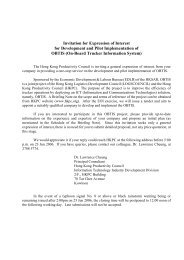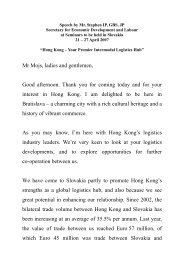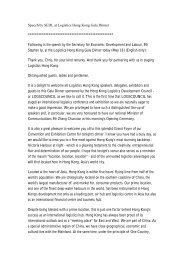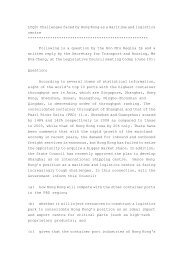Port, Maritime and Logistics Development Unit Economic ...
Port, Maritime and Logistics Development Unit Economic ...
Port, Maritime and Logistics Development Unit Economic ...
Create successful ePaper yourself
Turn your PDF publications into a flip-book with our unique Google optimized e-Paper software.
.…AppendicesFinal Report• Single sign-on – supports single sign-on capability such that participants can acquire servicesfrom multiple service providers by signing-on only once in the DTTN.• Access to value-added services – allows participants to invoke services offered by serviceproviders or other participants via the DTTN portal.The functional blueprint of the DTTN is depicted in Figure 1-2 below.The DTTNElectronic messagetransformation servicesCommunityElectronic messagerouting servicesFreig htforwardersInspectionagenciesGovernm ent & its agenciesHK SARBanks <strong>and</strong>financialinstitutionsOverseasBoleroCargoSmartSellers/exportersGT Nex usData inheritanceservicesInsurancecompaniesTerminalsAirSeaBuyer s/importers<strong>Port</strong>al servicesSeaTruckersCarriersAirRailOther serviceprovidersTradeCardINTTRATradelinkInformation securityservicesStatistical <strong>and</strong> analyticalreporting servicesFigure 1-2Functional blueprint of the DTTNIn addition to those communities <strong>and</strong> businesses involved in the trade <strong>and</strong> logistics processes,service providers will also be key stakeholders of the DTTN. Generally, service providers offersoftware solutions <strong>and</strong> services which assist customers to achieve better efficiency <strong>and</strong> effectivenessin their supply chain <strong>and</strong> logistics operation, as well as better integration with their businesspartners along the supply chain or trade flow. Third party service provision is a vital component ofthe DTTN model. The DTTN provides a flexible, neutral <strong>and</strong> open infrastructure to enable serviceproviders to further extend their offerings <strong>and</strong> deliver additional value added services. Serviceproviders will enjoy benefits from the DTTN in a number of ways: By reducing infrastructure cost to deliver their services By extending their business reach in terms of customers <strong>and</strong> business partners By improving speed to market for their value-added offerings By focusing resources on the development <strong>and</strong> delivery of value-added services8
AppendicesFinal ReportHistorically, messaging services were provided in closed <strong>and</strong> proprietary environments as ValueAdded Network (VAN) services usually associated with traditional EDI (store <strong>and</strong> forward)methods of conducting e-commerce. Since the emergence of the Internet, many service providersare now delivering their messaging services as “point to point” communications. These areoffered together with other value added services delivered over the Internet as ASPs or ISPs. Sincethere is no network processing cost this latter form of Internet communications is significantly lessexpensive than the traditional VAN. However, since the DTTN can be accessed from a VAN or anyISP <strong>and</strong> can offer access to an ASP it can offer an alternative communications channel for theseservice providers. DTTN will offer non-exclusive access to a valuable community of users that willgenerate a competitive market for all service providers.1.2.4 Technical blueprintThe technical blueprint for the DTTN design is characterised by the following attributes: Componentised <strong>and</strong> modular. The model technical architecture for the DTTN has beendeveloped based on a modular <strong>and</strong> componentised architecture to protect investment, allowmore technology choices, facilitate upgrades, <strong>and</strong> improve scalability. Robust, secure <strong>and</strong> reliable. The proposed DTTN architecture balances proven technologyoptions <strong>and</strong> new, emerging technologies. Security, reliability, high availability <strong>and</strong> other criticalfeatures (e.g., guaranteed delivery, non-repudiation, etc.) of the messaging infrastructure weretaken into account in the architectural development. Open <strong>and</strong> accessible. The architecture will support multiple st<strong>and</strong>ards <strong>and</strong> protocols indifferent areas (e.g., multiple message st<strong>and</strong>ards, multiple coding st<strong>and</strong>ards, etc.), <strong>and</strong> provideflexibility to accommodate convergence over time. To broaden usage <strong>and</strong> encourage adoption,multiple channels <strong>and</strong> open access mechanisms were emphasised. The details of theconnectivity module of the DTTN will be open <strong>and</strong> published to encourage the integration <strong>and</strong>development of other value-added services for the DTTN.Technically, the DTTN is a messaging hub that provides a transformation service <strong>and</strong> facilitates thecommunication among various trading parties through the exchange of messages conforming to aset of defined <strong>and</strong> agreed message st<strong>and</strong>ards. As illustrated in Figure 1-3, the DTTN leverages theInternet as the public network infrastructure to transfer information from the sender to the recipient.9
AppendicesFinal Reportthat entity is perceived by the industry stakeholders as neutral <strong>and</strong> non-exclusive, then thecommercial entity can be a viable option.• Neutrality in this context refers to the intention <strong>and</strong> ability of a commercial entity to providea level playing field for all industry stakeholders without undue bias towards a particularsector. This entity must therefore be perceived by all stakeholders as free from real orpotential conflict of interest which would otherwise compromise the stakeholders’ interests.• Non-exclusivity relates to the provision of fair access to all stakeholders. This implies thatno means or measures should be used by the DTTN’s operator to preclude particular groupsof customers from using the DTTN in practice, <strong>and</strong> thereby create undue competitiveadvantage for some stakeholders.1.3.2 A community-based company This model is a proven model adopted for similar initiatives overseas (e.g., Australia’sTradegate, the U.K.’s Felixstowe Cargo Processing System (FCPS)/ Destin8). This model is predicated on gaining wide ranging industry support to the agreed solution. Toachieve this will require strong neutral leadership with perceived neutrality to drive the DTTNprogram. This is a particularly important factor to be considered for the extremely fragmentedlogistics industry in Hong Kong that is largely an SME domain. Funding is a key concern for this institutional model. SMEs, are the largest sector, weakestfinancially, <strong>and</strong> the most fragmented community in the logistics industry. As such they areunlikely to have the ability to contribute to the funding of the DTTN in the short term. Indeed itmay be necessary to provide financial support, subsidy or incentive for the SMEs to participatein the DTTN.1.3.3 A government-led entity Some similar overseas initiatives that were studied are owned either fully or partially by theGovernment (e.g., the Netherl<strong>and</strong>s’s W@VE 1 , the U.S.’s Freight Information Real-time Systemfor Transport (FIRST)). Be it in a form of statutory body, government-owned company, or public corporation, the keychallenge for a government-led entity is to progress the DTTN initiative in the shortest possibletime, given the time required for funding approval <strong>and</strong> possible legislation. Public resources are always limited <strong>and</strong> must be used in an effective, accountable <strong>and</strong>transparent manner. Government will assess initiatives <strong>and</strong> allocate public fundingappropriately to support those with high priority, i.e. initiatives that represent the most effectiveuse of public resources <strong>and</strong> can only be implemented with the support of public funding.1.4 Next stepsDuring the study, a series of baseline estimates were developed including indicative benefits,implementation timeframe <strong>and</strong> investment requirement associated with creating the DTTN. Theseestimates were developed for two reasons: firstly to provide a perspective on the order of1 Web Application voor Voormelden met EDI (English equivalent: Web @pplication for EDI)11
AppendicesFinal Reportmagnitude of a program of this nature; <strong>and</strong> secondly to provide a baseline against which thealternative options can be measured. The highlights of this baseline analysis are: Benefits. The DTTN will deliver an estimated total benefit of HK$11.8 billion 2 to the trade <strong>and</strong>logistics industry over a 17-year timeframe. Implementation timeframe. Releases 1 <strong>and</strong> 2 of the DTTN development are both estimated totake around 12-15 months after the necessary funding approval <strong>and</strong> mobilisation. Investment requirement. In total, the direct investment to develop <strong>and</strong> operate the DTTN over a17-year timeframe is estimated to be around HK$3 billion.During the Study, a number of industry participants <strong>and</strong> service providers expressed their interestor willingness to create, own <strong>and</strong>/ or operate the DTTN for Hong Kong. Indeed more than onecommercial entity has claimed to be capable of doing so at less cost <strong>and</strong> in a shorter timeframe.Clearly, there is recognition of the need for, <strong>and</strong> a strong interest <strong>and</strong> willingness within theindustry to create the DTTN. However, there remain two challenges that need to be addressed:1. Industry acceptance. Any operator of the DTTN will require broad support from the logisticscommunity as a whole to maximise the number of participants over time. They will need todemonstrate neutrality, integrity, financial st<strong>and</strong>ing <strong>and</strong> a commitment to comply with theguiding principles.2. Involvement of SMEs. The full realisation of the DTTN value propositions is based on gainingSME involvement <strong>and</strong> active participation. Strategies <strong>and</strong> actions will be required to allowthese important members to actively participate in the DTTN <strong>and</strong> reap the rewards accordingly.To address these challenges <strong>and</strong> sustain industry support for the DTTN it is recommended that theGovernment continue to lead the next stages in the development of the DTTN. Specifically, it isrecommended that the Government take the following immediate next steps: Explore various collaboration approaches with the private sector to jump-start the DTTNprogram, <strong>and</strong> formulate an appropriate sourcing strategy for the program. Any solution mustaddress both the supply side of the equation (i.e., delivery of the DTTN at the lower level ofinvestment <strong>and</strong> in a quicker timeframe) as well as the dem<strong>and</strong> side (i.e., adherence to the basicblueprint functions <strong>and</strong> business principles). This will require strong leadership <strong>and</strong>negotiation skills. Determine the appropriate financial contribution, either direct or indirect, that the Governmentmay be required to make. This financial contribution could take the form of direct cash injectionas an investor in the DTTN or indirect contribution such as tax breaks or subsidies to theparticipants of the DTTN. Develop <strong>and</strong> conduct a structured, transparent, <strong>and</strong> accountable process to invite business <strong>and</strong>technical proposals for the development <strong>and</strong>/ or operation of the DTTN. The process should bedesigned to ensure the DTTN addresses industry requirements on a minimalist, neutral, lowcost basis with the necessary control mechanism to ensure compliance with the guidingprinciples. The baseline scenario developed will serve as the objective benchmark forcomparing alternatives.2 On a conservative basis, only benefits from operational efficiency improvements are included in the estimation with correspondingDTTN adoption rate assumption. Strategic benefits are not quantified here.12
AppendicesFinal Report Continue to engage the logistics industry to sustain the momentum of the initiative. Theindustry will need to be consulted on any proposals to develop <strong>and</strong>/ or operate the DTTN.The role of the Government in this respect will be twofold: on one h<strong>and</strong> the Government will actas the negotiator on behalf of the industry to deal with potential DTTN operators, <strong>and</strong> to refine<strong>and</strong> produce a proposal acceptable to the industry at large; on the other h<strong>and</strong> the Governmentwill act as the facilitator for the industry to select <strong>and</strong> obtain buy-in for an appropriate proposalfor the DTTN program. The involvement of PMLDU should continue <strong>and</strong> be exp<strong>and</strong>ed asnecessary to play these roles. Enlist participation from the industry in the establishment <strong>and</strong> ongoing operation of the DTTN.The Government should help secure participation from the industry in the DTTN during itsestablishment <strong>and</strong> ongoing operation. The Government should lead by example <strong>and</strong>demonstrate its commitment through:• Offering to promote the DTTN to overseas countries through established official channelsfor trade related matters; <strong>and</strong>• Taking actions to ensure the participation of SMEs in the DTTN including further education<strong>and</strong> if appropriate financial assistance to acquire necessary IT equipment/ training.13






